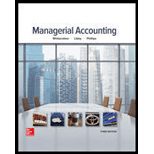
Concept introduction:
Degree of Operating Leverage:
It is a measure to calculate the change in operating income of the company with reference to change in the contribution margin respectively.
Requirement 1
To discuss:
The implications of the degrees of operating leverage given for two companies.
Concept introduction:
Degree of Operating Leverage:
It is a measure to calculate the change in operating income of the company with reference to change in the contribution margin respectively.
Requirement 2
To compute:
The total contribution margin for two companies.
Concept introduction:
Degree of Operating Leverage:
It is a measure to calculate the change in operating income of the company with reference to change in the contribution margin respectively.
Requirement 3
To discuss:
Thecost structures forD company and G company.
Want to see the full answer?
Check out a sample textbook solution
Chapter 6 Solutions
Managerial Accounting
- ??!!arrow_forwardA company purchased a cutting machine for $250,000. The machine has a useful life of 10 years and a residual value of $15,000. It is estimated that the machine could produce 100,000 units over its useful life. In the first year, 20,000 units were produced. In the second year, production increased to 25,000 units. Using the units-of-production method, what is the book value of the machine at the end of the second year?arrow_forwardKindly help me with this Financial accounting questions not use chart gpt please fast given solutionarrow_forward
- Financial Accountingarrow_forwardHayden Manufacturing computes its predetermined overhead rate annually on the basis of direct labor hours. At the beginning of the year, it was estimated that 40,000 direct labor hours would be required for the period's estimated level of production. The company also estimated $520,000 of fixed manufacturing overhead expenses for the coming period and variable manufacturing overhead of $4 per direct labor hour. Hayden's actual manufacturing overhead for the year was $684,000, and its actual total direct labor was 41,200 hours. Required: Compute the company's predetermined overhead rate for the year.arrow_forwardGeneral accounting question and right solutionarrow_forward
- I need help with this solution and general accountingarrow_forwardSuppose the required reserve ratio is 0.20 and individuals hold no cash. Total bank deposits are $150 million, and the banks hold $40 million in reserves. How much more money can the bank create if it does not hold excess reserves?arrow_forwardElena gives stock to Jake that has a tax basis of $4,500. At the time of the gift, the stock is worth only $3,800. Jake later sells the stock for $5,000. What amount of gain must Jake report on the sale?arrow_forward
 Managerial AccountingAccountingISBN:9781337912020Author:Carl Warren, Ph.d. Cma William B. TaylerPublisher:South-Western College Pub
Managerial AccountingAccountingISBN:9781337912020Author:Carl Warren, Ph.d. Cma William B. TaylerPublisher:South-Western College Pub Excel Applications for Accounting PrinciplesAccountingISBN:9781111581565Author:Gaylord N. SmithPublisher:Cengage Learning
Excel Applications for Accounting PrinciplesAccountingISBN:9781111581565Author:Gaylord N. SmithPublisher:Cengage Learning

